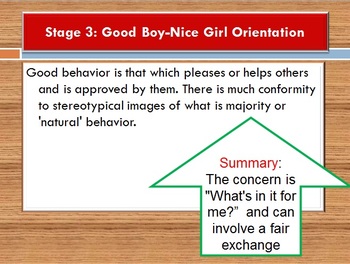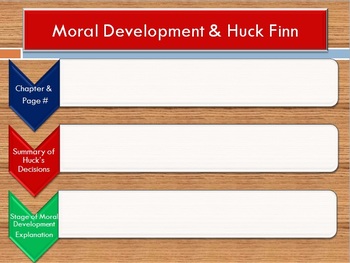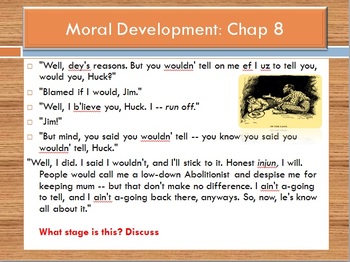Huckleberry Finn and The Six Stages of Moral Development
ELA Reading and Writing Resources
310 Followers
Grade Levels
10th - 12th, Higher Education
Subjects
Resource Type
Formats Included
- PPTX
Pages
37 pages
ELA Reading and Writing Resources
310 Followers
Description
One of the most prominent conflicts within The Adventures of Huckleberry Finn is the Individual Vs. Society. The following lesson explores Huck’s moral decisions (both good and bad) to help teach higher ethical values in the classroom. The lesson works first by engaging students in a psychology study called, “The Heinz Dilemma.” Students share and respond with their thoughts to morally ambiguous situations through the Socratic method, or through a class discussion facilitated by the teacher. After the case scenario, students take notes on Kohlberg’s Six Stages of Moral Development. Students then learn and discuss what stages they fell into when making moral decisions during "The Heinz Dilemma." Upon completion of “The Heinz Dilemma,” students apply what they have learned toward analyzing Huckleberry Finn’s choices in chapters 8, 16, 26, 40, 42, and 43 by using the following Core Questions:
Do Huckleberry Finn’s decisions become more complex throughout the novel? Do Huck’s morals evolve, and if so, what is the author’s purpose and showing us the moral evolution of this character?
This assignment requires that students in small groups complete graphic organizers, make mini presentations on what they find about Huck’s choices and fill out a chart using information other student groups present. When the lesson is completed, students will understand that while Huck’s moral compass is not always consistent (even by the end of the text), his choices indeed become more complex. Like Atticus Finch, John Proctor or Guy Montag; Huckleberry Finn portrays the quintessential individual Vs. society conflict. Not only does this lesson facilitate how Twain uses Huck as a vehicle to satirize the institution of slavery and human nature; additionally, the lesson helps students challenge and monitor their own Moral decision making processes.
(Note- once the lesson is completed, the same lesson can be generated to observe and discuss the values of other protagonists throughout the rest of the school year as well.)
Please email Junco22@yahoo.com for handouts. Additionally, I have this PowerPoint saved in multiple formats. I would be happy to send the PowerPoint in any format you request!
Do Huckleberry Finn’s decisions become more complex throughout the novel? Do Huck’s morals evolve, and if so, what is the author’s purpose and showing us the moral evolution of this character?
This assignment requires that students in small groups complete graphic organizers, make mini presentations on what they find about Huck’s choices and fill out a chart using information other student groups present. When the lesson is completed, students will understand that while Huck’s moral compass is not always consistent (even by the end of the text), his choices indeed become more complex. Like Atticus Finch, John Proctor or Guy Montag; Huckleberry Finn portrays the quintessential individual Vs. society conflict. Not only does this lesson facilitate how Twain uses Huck as a vehicle to satirize the institution of slavery and human nature; additionally, the lesson helps students challenge and monitor their own Moral decision making processes.
(Note- once the lesson is completed, the same lesson can be generated to observe and discuss the values of other protagonists throughout the rest of the school year as well.)
Please email Junco22@yahoo.com for handouts. Additionally, I have this PowerPoint saved in multiple formats. I would be happy to send the PowerPoint in any format you request!
Total Pages
37 pages
Answer Key
N/A
Teaching Duration
N/A
Report this resource to TPT
Reported resources will be reviewed by our team. Report this resource to let us know if this resource violates TPT’s content guidelines.





